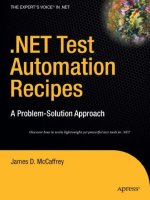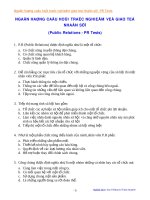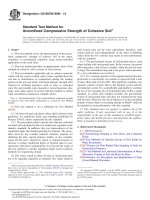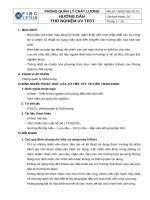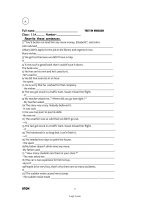Test Test Test estTes tTestT estTest
Bạn đang xem bản rút gọn của tài liệu. Xem và tải ngay bản đầy đủ của tài liệu tại đây (144.91 KB, 3 trang )
Board Policy
2.10.015-P
Anti-Racist & Anti-Oppression
Learning Communities
I.
Purpose
Portland Public Schools is committed to an anti-racist and racial equity and social justice
approach to public education to ensure a learning environment that is free from hate and the
legacy of school segregation and institutional racism for all students and staff. The District
unequivocally affirms that Black lives matter. We believe in the fundamental right to human
dignity and that generating an equitable world requires an educational system that intentionally
disrupts—and builds leaders to disrupt—systems of oppression.
We can begin the process of healing through our policies and curriculum to address cultural and
institutional racism. The District must create an inclusive environment that reflects and
supports the racial and ethnic diversity of our student population and community.
Every student is entitled to a high-quality educational experience, affirming and free from
discrimination or harassment based on perceived race, color, ethnicity, religion, gender identity,
sexual orientation, disability, or national origin.
Every employee is entitled to work in an environment that is affirming and free from
discrimination or harassment based on perceived race, color, religion, gender identity, sexual
orientation, disability, or national origin.
Every visitor is entitled to participate in an environment that is affirming and free from
discrimination or harassment based on perceived race, color, religion, gender identity, sexual
orientation, disability, or national origin.
II.
Definitions
1.
“Bias incident” means a person’s hostile expression of animus toward another
person, relating to the other person’s perceived race, color, ethnicity, religion, gender
identity, sexual orientation, disability, or national origin of which criminal investigation or
prosecution is impossible or inappropriate. Bias incidents may include derogatory
language or behavior directed at or about any of the preceding demographic groups.
2.
“Symbol of hate” means a symbol, image, or object that expresses animus on the
basis of race, color, religion, gender identity, sexual orientation, disability, or national
origin including, the noose, swastika, or confederate flag, and symbols contained in the
Hate on Display Hate Symbols Database. and whose display:
a.
Is reasonably likely to cause a substantial disruption of or material
interference with school activities; or
Page 1 of 3
b.
Is reasonably likely to interfere with the rights of students to full access to
the services, activities, and opportunities offered by a school or program; or
c.
Is reasonably likely to create a hostile educational environment which
interferes with the psychological and emotional well-being of a student.
3.
“Hate Speech” means the written, verbal, visual or symbolic expression of
animus on the basis of race, color, religion, gender identity, sexual orientation, disability,
or national origin.
III.
Expectations and Consequences
We will not tolerate in our schools, programs, activities, or on our property any symbolsof hate
that are disruptive to the learning environment; contain language, symbols, or images that are
discriminatory; are recognized to promote hate or violent conduct; or contain threats. These
include, but are not limited to, student and adult apparel, accessories, gestures, or other
symbols such as those that depict symbols of
hate. Exceptions will be made where symbols are used in teaching curriculum and otherlearning
opportunities that are aligned to the Oregon State Standards and support the goals of this
policy. The District will incorporate learning opportunities to support the goals ofthis policy.
The District has adopted restorative justice practices in the belief that they help resolve conflicts
and enable healthy, supportive, and inclusive communities. As part of this practice, the District
will endeavor to address incidents of bias and hate speech using this approach. Additionally, if
this policy is violated by students, the District will assess whether disciplinary action is required
under the Student Conduct and Discipline Policy. Adults who engage in hate speech or bias
incidents may be subject to discipline and/or be prohibited from coming upon District property.
The District prohibits retaliation against any individual because that person has in good faith
filed a charge, testified, assisted, or participated in an investigation, proceeding, or hearing; and
further prohibits anyone from coercing, intimidating, threatening, or interfering with an individual
for exercising any rights guaranteed under state and federal law.
Nothing in this policy is intended to interfere with the lawful use of District facilities pursuant to a
lease or license.
END OF POLICY
In responding to the use of any symbols of hate, the District will follow the procedures outlined
in the Anti-Racist Learning Communities Administrative Directive found here.
A glossary of definitions of the types of behavior and beliefs that are instrumental in the
development of bias incidents can be found here: [hyperlink to glossary]
Page 2 of 3
Legal Reference(s):
ORS 659.850; ORS 659.852; OAR 581-002-0005; OAR 581-022-2312; OAR 581-022-2370
Tinker v. Des Moines Indep. Cmty. Sch. Dist., 393 U.S. 503 (1969).
Dariano v. Morgan Hill Unified Sch. Dist., 767 F.3d 764 (9th Cir. 2014).
State v. Robertson, 293 Or. 402 (1982).
OSBA:
ACB
Adopted:
2/9/2021
Page 3 of 3
